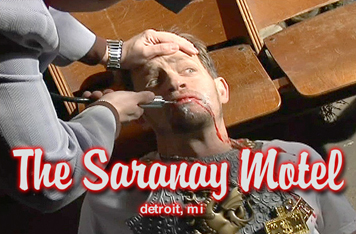
Still from The Sarany Motel, a film by Elliott Earls, 2007
This fall, Elliott Earls, head of the 2-D Design Department at Cranbrook Academy of Art, will release his second feature-length film The Sarany Motel, which he produced, directed, stars in, composed the music for, and edited. Through his diverse body of work Earls has pushed the boundaries of design authorship perhaps more than any other graphic designer, but the field has changed a great deal since he released Throwing Apples at the Sun, his first major foray into film/music/design hybrid over a decade ago. The release of The Sarany Motel comes amidst a flood of self-published books, podcasts, zines, and blogs by designers. It no longer seems quite as audacious for a designer to make a movie. Instead it raises questions like: Has the dominance of the "designer as author" model transformed graphic design into a vague form of cultural production?; and, Is the allure of the legitimacy of authorship pulling design away from the defining characteristic of the profession — the designer/client relationship?
Trailer for The Sarany Motel, a film by Elliott Earls, 2007
Notions of authorship have percolated in graphic design and criticism since the early 1990s when the field finally shrugged off the problem-solving model of late Modernism. Of his early efforts during this period Earls writes, "I fashioned myself a later day Herman Melville attempting to craft the great American novel (through this new medium)." But as with most reactionary ideologies, the transition from insurgent critique to mainstream dogma has been problematic. Shortly after the release of Throwing Apples..., Michael Rock published his 1996 essay, "The Designer as Author." The text put the authorial model in a rigorous historical context. Rock breezes through conceptions of the author from Barthes to Foucault, and in the work of Lupton/Miller, McCoy, Carson, Greiman, and others, but he remains skeptical. He writes, "theories of authorship also serve as legitimising strategies, and authorial aspirations may end up reinforcing certain conservative notions of design production and subjectivity." He never fully embraces any of the perspectives he reviews and ends with a string of contingencies: "It may be that..."; "An examination of the designer-as-author could help us..."; "we must still work to engage these problems in new ways"; etc. The only point he makes emphatically is that authorship reflects an insecurity about the merit of design on its own terms.
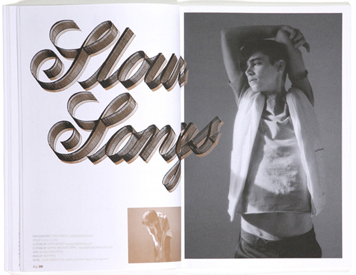
Spread from Untitled 001, self-published fashion magazine by Mike Perry, 2007. The editor's note reads, "Every issue will be a direct reflection of my inspiration and mood at the moment I'm assembling it." This is the authorial prerogative writ large, but ultimately this magazine will flourish or fail based on the content itself.
Ironically, despite his nuanced analysis, Rock's essay has become a point of reference for precisely the kind of legitimizing strategy he sought to debunk. There have been conferences, exhibitions, essays and countless blog posts devoted to the designer as author. Terms like self-authored, self-generated and self-initiated have proliferated. The School of Visual Arts changed the name of its Graphic Design MFA program (one of the nation's finest, co-chaired by Design Observer contributing writer Steven Heller) to the MFA Designer As Author degree program. The mission statement reads, "The concept of authorship is, first and foremost, rooted in the independent creation of ideas." The text goes on, "The 'MFA Designer As Author' is predicated on the growing need for content providers throughout the visual media." Of course this begs the question, Then why not an MFA in content production? but the program is clearly responding to a change in the aspirations and prospects for students of design. The program that Earls heads defines these prospects in even broader terms. The "Departmental Doctrine" reads in part, "It's a 'love' thing. The goal in life is to quit responding to societal pressure, fear, and desire, and to attempt to gain a deeper understanding of one's true nature."
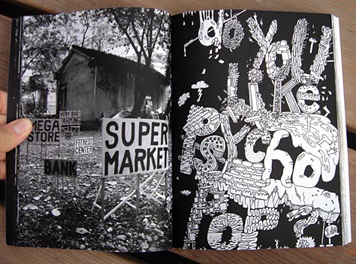
Spread from And There Will Be Light, self-published book by design team Flag: Bastien Aubry and Dimitri Broquard, 2007
The problem with the authorship model is that it replaces a tangible engaged client with a vague notion of a market, passively waiting to consume (or more likely ignore) the self-generated work of the designer (as author). A quick look through just about any designer monograph reveals the problem with this shift. Iconic works of design have generally been buoyed by the cultural or economic relevance of the clients involved. Robert Brownjohn's titles for Night of the Generals are refined but people remember those he did for Goldfinger and From Russia with Love in large part because of the movie that followed the titles. If you lined up all of Peter Saville's album covers you probably wouldn't pick out Joy Division's Closer as the cherry of the bunch. But the music on that album and the band's continued cultural influence have elevated the cover above the rest. The designer/client relationship is integral not only to the historical fate of a designer's work but to the creative process itself. This is what makes the graphic design process unique.
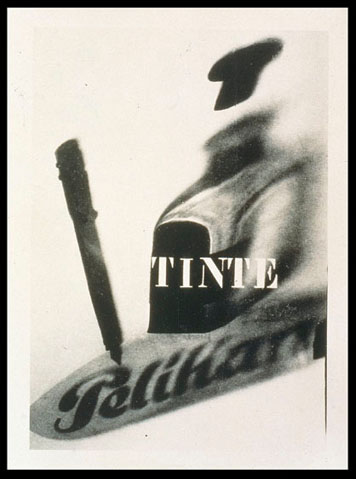
Advertisement for Pelikan drawing ink, designed by El Lissitsky, 1925
In a 2005 essay titled "Fuck Content," Michael Rock revisits the authorship debate. He points to icons of design history such as Raymond Loewy's Lucky Strike pack and El Lissitzky's Pelikan ink advertisement to make the point that content is essentially irrelevant to design quality. He writes, "The stellar examples of graphic design are often in service of the most mundane content possible...But despite the banality of the content, the form has an important, even transformative meaning." Although I agree with the central point, Rock glosses over the critical importance of the client and the economic context of the design. The content of the Pelikan ad may not be compelling but the product clearly was. This goes beyond the fact that Pelikan decided to work with Lissitsky and paid to have this advertisement placed. This poster probably would have disappeared into obscurity without the commercial success of the product. The Pelikan customer was the right audience for Lissitsky's work. This is the symbiosis between the economic and the formal that Rock overlooks.
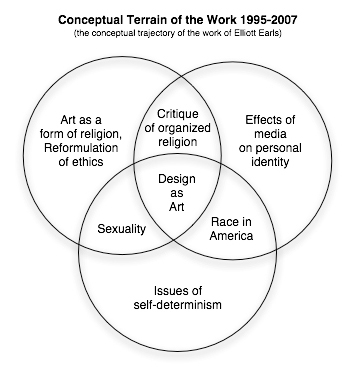
Conceptual Terrain of the Work 1995-2007, Elliott Earls, 2007
Earls has done his best to confound this symbiosis. He proudly describes getting fired from his one and only "real" design job at Elektra Records in 1993 and proclaims, "First and foremost I see myself as a contrarian and a social critic." He takes great pains to distance himself from the design profession, and yet he is the head of a graphic design program and he has been quite successful finding an audience within design. His DVDs are distributed by Emigre, and he lectures and exhibits in Design programs around the world. It is only by putting authorship to the side and examining the context that we get a clear sense of Earls' work.

Kate Valk appearing in a Wooster Group performance of Eugene O'Neil's Houselights, directed by Elizabeth Lecompte, 1998
The economic boom in Lower Manhattan in the mid-1990s is critical to this understanding. The downtown theater community of that era played a significant role in Earls' career. The enduring experimental performance space Here hosted his first performance in 1995 and later he was awarded an Emerging Artist Grant from the Wooster Group. These venues helped Earls shift his work from enhanced CDs to "technologically mediated poetry reading," to the cycles of performance pieces, digital films, sculptural and photographic works he now produces. At that time, the Wooster Group was staging shows that included heavy use of video. They were actively developing an audience for so-called multi-media performances. This brand of technology-infused work was particularly appealing to the creative professionals of Silicon Alley who had a lot riding on the promise of technology and specifically multi-media. In this context Earls' pursuit of a hybrid of technology and performance makes a great deal of sense.

Enron logo, designed by Paul Rand, 1996
Unfortunately contextual questions like these are generally reserved for discussions of "activist" design or social responsibility. Designers are criticized for working for a certain client (say, big tobacco) or lauded for working for others (say, museums). This is a nostalgic view in an economy where tobacco companies are major supporters of museums. Shifting a design critique to an ideological one gets immediately mired in the complexity and inter-connectedness of our global economy. In a world where the Federal Reserve can't sort out who will be left holding the bag in the current home mortgage crisis, it is unlikely that design critics will be able to assess the fiduciary ethics of a print campaign. Perhaps this is another reason that this kind of critique has been unpopular — it is difficult to sort out the significance of design events as they happen. Paul Rand's work for IBM is widely celebrated, but would that be the case if IBM had gone the way of Enron, whose identity he also designed? How has Rand's work been impacted by the disastrous, criminal collapse of the company? This sort of guilt by association (and vice versa) should be a subject of design criticism.
Throughout his career Earls has carefully removed himself from any recognizable graphic design context. He calls his work art or poetry, but this raises an unfavorable comparison to artists like Matthew Barney and Doug Aitken who have used film to organize an inter-disciplinary practice. Earls makes music that is not meant to be listened to as music, and art that's not for the gallery. The downtown theater scene that first embraced his performances is still the most suitable context for his work, but he would probably resist even this as over-simplification. Instead, he prefers to constantly shift his role and context. His work is an extreme example of a posture that is increasingly widespread in graphic design — the designer as dilettante.
The best hope for this new breed of hybrid designer might be that the ubiquity of the authorship model will create a micro-economy that can sustain products whose primary distinguishing characteristic is that they were made by graphic designers. A designer is more likely to be interested in a fashion magazine produced by a designer/editor, and might be predisposed to prefer a mix-tape by a designer/DJ. (Just like the early Internet entrepreneurs were predisposed to like the technology-infused performances of the Wooster Group.) But for every Shephard Fairey, or Jop Van Bennekom who finds a wide audience, there are thousands of sticker-making, tee-shirt silk-screening designers whose zine probably would have been better if it was written by a writer. Without the energy and expertise of the client, self-initiated projects rarely attain the cultural significance necessary to become iconic works of graphic design.
The most compelling section of Rock's "The Designer as Author" examines the theory of the auteur director as conceived by the American film critic Andrew Saris. The connections that Rock draws between the director and the designer are astute, "over the course of a career both the film director and the designer work on a number of different projects with varying levels of creative potential. As a result, any inner meaning must come from aesthetic treatment as much as from content." In "Fuck Content," Rock stands by this as the most enduring part of the original essay adding, "The auteurship, and the meaning of the work, of the director's work is embedded not in the story but in the storytelling." The contingent control that directors and designers have over their work is significant but once again Rock misses a critical distinction — directors work exclusively in the film business and designers float about in all areas of the economy. This fluid relationship to capital means that the designer is fundamentally responsible for his position vis-à-vis capital. The designer's work is defined not just by aesthetic treatment but by the economic and social context they work in.
For the last decade, designers like Elliott Earls have been able to straddle both worlds, keeping just enough client work going to support their authorship. For many, a career in graphic design means being a part-time publisher, writer, filmmaker, DJ or artist. But the quest for authorship may jeopardize the economic and cultural free agency that defines the field. If the designer is author, what becomes of the designer as designer?
